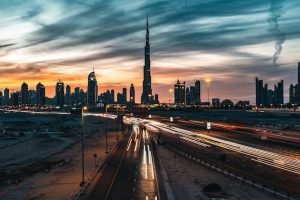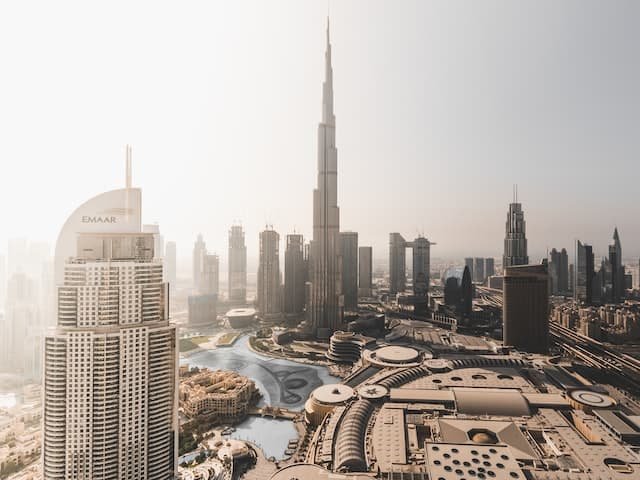Ever question how the iconic Burj Khalifa came to life? Follow us on a journey through the history of Burj Khalifa in English. Learn how engineers, designers, and architects worked together to build one of the world’s tallest and most defined structures. Take a look at the challenges they faced, the technologies they used, as well as their creative solutions.
Introduction: Overview of Burj Khalifa
The Burj Khalifa, before the Burj Dubai, is the tallest structure ever in history. It is a mega-tall tower with a height of 829.8 m (2,722 ft), located in Dubai, United Arab Emirates. Construction of the Burj Khalifa began in 2004 and was completed in 2009. Adrian Smith of Skidmore, Owings & Merrill LLP created the structure.  The primary structure of the Burj Khalifa is made up with increase concrete and steel. The exterior facing consists of aluminum and glass. The building has 163 floors, with a height of 555 m (1,821 ft). There are 54 elevators and 8 escalators in the building. The Burj Khalifa was built as part of a large development project called Downtown Dubai. The project also includes 30,000 homes, 9 hotels, over 200 stores, malls, parks and recreation areas, and more.
The primary structure of the Burj Khalifa is made up with increase concrete and steel. The exterior facing consists of aluminum and glass. The building has 163 floors, with a height of 555 m (1,821 ft). There are 54 elevators and 8 escalators in the building. The Burj Khalifa was built as part of a large development project called Downtown Dubai. The project also includes 30,000 homes, 9 hotels, over 200 stores, malls, parks and recreation areas, and more.
History, Design, and Architecture of the Burj Khalifa
A famous tower in Dubai, United Arab Emirates, is the Burj Khalifa. It is the tallest structure ever made in the world, standing at 829.8 meters (2,722 feet). The building is finished in 2010 and has 160 stories. The design of the Burj Khalifa was excited by the desert flower, In particular the Hymenocallis (spider lily). The shape of the tower is modeled after a mosque’s tower, which is also a standard symbol of Dubai. The exterior of the Burj Khalifa is covered with pensive glass. Which helps to keep the building cool in Dubai’s hot desert climate. The building also has advanced engineering and survival features. Such as a double-skin front that helps to regulate temperatures inside the building. The interior of the Burj Khalifa is just as grand as its exterior. The hall features a grand Atrium that is over 150 meters (490 feet) tall and has floor-to-ceiling windows that offer amazing views of Dubai. There are also many luxury hotels and home rooms located within the building.
Structural Engineering and Construction Process
Structural engineering is a vital part of the construction process of any tall building, and the Burj Khalifa is no protest. The building’s design and construction were ruled by a team of engineers from Skidmore, Owings & Merrill LLP (SOM), who are the brains behind some of the world’s most iconic towers.
The Burj Khalifa’s structural system consists of a concrete core with built concrete border columns. The core wall is over 4 meters thick at its base and tapers to just over 1 meter thick at its peak. This thick concrete core provides balance for the building in high wind terms. The border columns are spaced about 3 meters apart and connected to the core wall via steel beams. The steel beams that connect the border columns to the concrete core are also answerable for supporting the weight of the exterior. The cladding is made up of more than 26,000 triangular panels, which were installed using a “unified curtain wall system”. This system involves performing the panels in a factory setting, before shipping them to the construction site and installing them on the building. The installation of the exterior cladding was a careful process that took place over a period of several months.
- First, the aluminum frames that make up each panel were installed in the building.
- Next, the glass panes were inserted into these frames. Before they are sealed with silicone.
Challenges in Building the Iconic Tower
When it was first planned, the Burj Khalifa was imagined as a mixed-use development that would include a home, office, hotel, and trade space. However, the global cheap crisis of 2008 put a halt to those plans and forced the developers to focus on just the office and home parts. This presented a number of challenges for the design and construction teams.
- First, they had to find a way to make the building physically sound without the extra weight of the hotel and retail space.
- Second, they had to figure out how to include all the needed services (e.g., water, electricity, etc.) in a building that was already much taller than anything else in the world.
Happily, the team was up to the challenge and was able to overcome these issues. The end result is a truly iconic structure that has become an instantly noticeable part of the Dubai skyline.
Sustainability and Maintenance
One of the most noticeable structures in the entire globe is the Burj Khalifa. But how did they design and build it? This infographic takes a journey through the History of the Burj Khalifa, from the early days of its idea to its completion in 2010. It starts with an idea… In 2004, when The Emaar Properties Chairman Mohammed Alabbar licensed architect Adrian Smith + Gordon Gill Architecture to design a project that would become the tallest building in the world. They started with sketches… which turned into 3D models… which turned into construction drawings. Then, the construction process began.
- First, they hollow a huge hole in the ground… which took almost two years to complete.
- Next, they built the steel frame of the building… which took another two years.
- Finally, they added the finishing touches… and the Burj Khalifa was complete!
Now, over 10 years later, it stands as a statement of human feat… and a reminder of what we can accomplish when we set our minds to it.
Conclusion
The journey to building the iconic Burj Khalifa was a long and arduous one, but it made way for more advances in design technology. Architects and engineers worked together to create something excellent that is talked about today. It’s amazing how much devotion and zeal went into constructing such a grand masterpiece. The construction of this tower not only boosted Dubai’s economy but also left us with an incredible reminder of human capability when it comes to engineering successes.




There are 3 comments
Now i know what exactly burj Khalifa? Very informative, thanks!